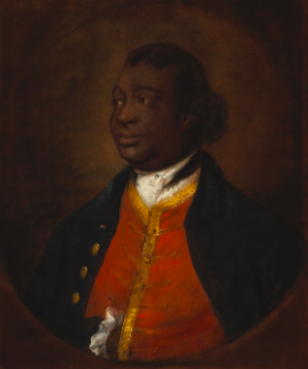Ignatius Sancho
(1729 – 1780)
Charles Ignatius Sancho was an Afro-British writer, actor and composer. He was formerly enslaved but gained fame in literary and artistic circles and thus became known as “the extraordinary Negro.” Sancho was born in 1729 on board a slave ship destined for the Spanish colony of New Granada. Shortly after his birth, his mother died. It has been reported that his father took his own life in opposition to being enslaved. Sancho was brought to England when he was two years old. From 1731 to 1749, he lived with his master’s three unwed sisters in Greenwich. During this time, Sancho met John Montagu, the 2 nd Duke of Montagu. The Duke found him to be very intelligent and sociable. He encouraged Sancho to read and lent him books from his personal library in Blackheath. In 1749, Sancho ran away from Greenwich to work as a butler for Mary Montagu, the Duchess of Montagu until her death in 1751. While at the Montagu House, Sancho immersed himself in music, poetry, literature and writing. Upon the Duchess’s death, Sancho inherited £70 as well as an annuity of £30, which he spent quickly and frivolously.
On December 17, 1758, he married Ann Osborne, a West Indian woman with whom he had seven children: Frances Joanna (1761-1815), Ann Alice (1763-1805), Elizabeth Bruce (1766- 1837), Johnathan William (1768-1770), Lydia (1771-1776), Katherine Margaret (1773-1779), and William Leach Osborne (1775-1810). At the peak of the national debate on slavery in 1766, Sancho wrote renowned writer and clergyman, Laurence Sterne, encouraging him to lobby for the abolition of the slave trade in his writings. Sterne responded to Sancho in a highly publicised letter on July 27, 1766. The letter became an essential part of 18 th century abolitionist literature. It has been theorized that Sancho and Gustavus Vassa must have known each other to some extent due to their mutual involvement in the London abolitionist movement. Over the years, Vassa spent a significant amount of time at the Guerin family’s home in Westminster, which was a few blocks away from Sancho’s place of residence.
In 1774, Sancho opened a grocery store with the help of the Duke of Montagu. During this time, he wrote and published two plays, as well as his literary piece, Theory of Music. Sancho owned a house in Westminster and was financially independent, making him eligible to vote in the parliamentary elections in 1774 and 1780. He became the first person of African descent to vote in Britain. He was an adamant supporter of the monarch and the attempt to defeat the American War for Independence. He wrote many letters and newspaper op-eds vocalizing his political views under his real name and his pseudonym “Africanus.”
On December 14, 1780, Ignatius Sancho died from complications derived from gout. He became the first person of African descent to receive an obituary in the British press. In 1782, The Letters of the Late Ignatius Sancho, a compilation of 160 of his letters, was released posthumously by Sancho’s correspondent, Frances Crewe. It remains one of the earliest accounts of slavery written in English by someone who was formerly enslaved. Sancho’s son, William Leach Osborne, inherited his grocery store, which he later reconstructed into a printing and book- selling business. In 1803, Osborne’s establishment printed the fifth edition of The Letters of the Late Ignatius Sancho With Memoires of His Life by Joseph Jekyll which featured a frontispiece of Sancho, engraved by the artist, Bartolozzi.
At some point during the 1750s or 1760s, artist Alan Ramsay painted the famous portraiture now known as, “Portrait of an African.” There has been much debate surrounding this painting. At one point the portrait was assumed to have been painted by another artist named Joshua Reynolds and was titled “Black Boy by Joshua Reynolds.” It is one of the few portraits of Africans portrayed in a gentlemanly manner rather than as an enslaved person or servant. The man in the painting was originally identified as “Olaudah Equiano,” based on his supposed resemblance to the portrait of Gustavus Vassa from the frontispiece in his memoir. Scholars have since indicated that this is not possible as the facial likeness is not there. Moreover, the painting has been dated to the late 1750s or early 1760s, during which time Vassa was enslaved and spent much of his life at sea with his slave masters, Michael Henry Pascal and Robert King. The painting appears to be of a wealthy man in his 20s or 30s. In the 1750s and 1760s, portraitures were expensive, making them not accessible for most people, let alone those who were enslaved. For these reasons, scholars have suggested the painting is more likely of Ignatius Sancho. His age and wealth during this time make him the likely sitter. Furthermore, Sancho’s master was an art collector who had regular correspondence with popular artists. This, along with his association with the literary and artistic elite of London lends further support to this theory.
RELATED FILES AND IMAGES
REFERENCES
Carey, Brycchan. “ The Equiano Portraits,” BrycchanCarey.com, published April 2002. https://brycchancarey.com/equiano/portrait.htm
Carey, Brycchan. “ ‘The Extraordinary Negro ’ : Ignatius Sancho, Joseph Jekyll, and the Problem of Biography,” British Journal for Eighteenth-Century Studies, 26:2 (2003), 1-13.
King, Reyahn. “Ignatius Sancho and Portraits of the Black Elite,” in Reyahn King, Sukhdev Sandhu, James Walvin and Jane Girdham, eds., Ignatius Sancho: An African Man of Letters (London: National Portrait Gallery, 1997), 15-43.
Madin, John. “The Lost African: Slavery and Portraiture in the Age of Enlightenment,” Apollo: the International Magazine of Art and Antiques (2006), 34-39.
Sancho, Ignatius. Letters of the Late Ignatius Sancho: An African, to which are Prefixed, Memoirs of His Life by Joseph Jekyll, Esq. (London: J. Nichols, 1782).
This webpage was last updated on May 9, 2020 - Fahad Q
 Portrait by Thomas Gainsborough (1768)
National Gallery of Canada, Ottawa.
Portrait by Thomas Gainsborough (1768)
National Gallery of Canada, Ottawa.